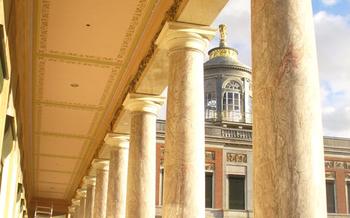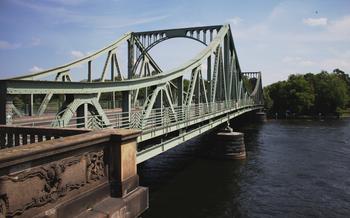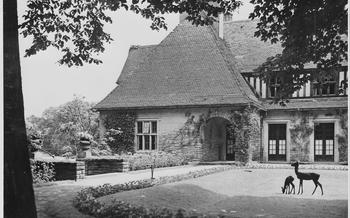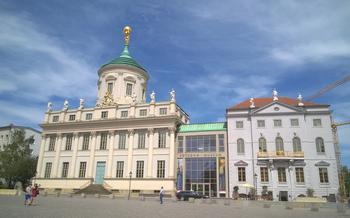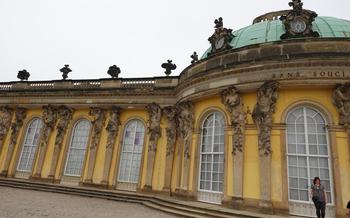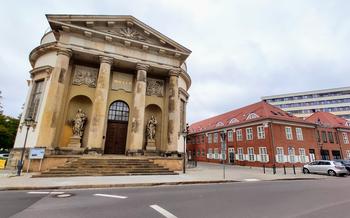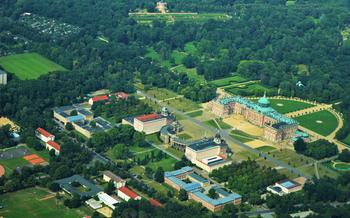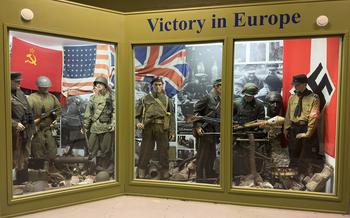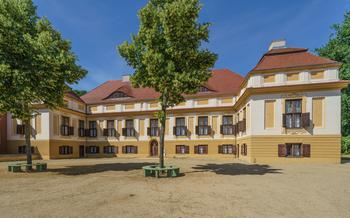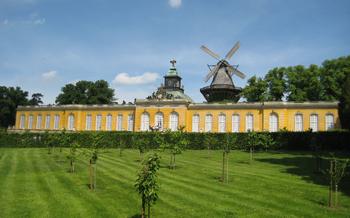
The Kulturquartier Schiffbauergasse
- The Kulturquartier Schiffbauergasse: An Overview
- Exploring the Creative Hub
- Historical Importance of the Site
- Architectural Highlights
- The Schiffbauergasse Bridge: A Symbol of Reunification
- The Nikolaisaal: A Renowned Venue
- Film Museum Potsdam: A Cinematic Gem
- Hans Otto Theater: A Stage for the Arts
- Potsdam Museum: Delving into Local History
- The Schinkelhalle: An Iconic Venue
- Outdoor Activities and Recreation
- Family-Friendly Attractions
- Insider Tip: Secret Gardens and Hidden Gems
The Kulturquartier Schiffbauergasse: An Overview
The Kulturquartier Schiffbauergasse, formerly known as Schiffbauergasse, is a vibrant cultural hub located in the heart of Potsdam, Germany. Originally an industrial site, it underwent a remarkable transformation into a thriving center for arts, culture, and innovation.
Steeped in history, Schiffbauergasse traces its roots back to the 18th century, when it served as a shipyard for the Prussian navy. The site played a vital role in Potsdam's shipbuilding industry, contributing to the city's maritime heritage.
The architectural style of Schiffbauergasse is a blend of historical charm and contemporary design. Many of the original industrial structures have been carefully restored and repurposed, while new buildings have been constructed in a modern and sustainable style. This harmonious fusion creates a unique and captivating environment that attracts visitors from all over the world.
Today, the Kulturquartier Schiffbauergasse is a thriving hub for creativity and cultural exchange. It encompasses art galleries, theaters, music venues, and cultural institutions, offering a diverse range of events and activities throughout the year. With its rich history, stunning architecture, and vibrant atmosphere, the Kulturquartier Schiffbauergasse has become a must-visit destination for anyone exploring Potsdam and its cultural treasures.
Exploring the Creative Hub
The Kulturquartier Schiffbauergasse is a vibrant creative hub that attracts artists, performers, and culture enthusiasts from around the world. The quarter is home to numerous art galleries and exhibition spaces, showcasing a diverse range of contemporary and historical artworks. Visitors can admire paintings, sculptures, photography, and mixed media installations, as well as participate in artist talks, workshops, and guided tours.
Theaters and performance spaces in the Kulturquartier offer a variety of productions, from traditional plays and musicals to experimental and avant-garde performances. Whether you prefer the intimacy of a small theater or the grandeur of a large stage, there is something for everyone to enjoy.
Music venues and concert halls in the quarter host a wide range of musical events, from classical recitals and jazz concerts to rock and pop performances. Renowned artists and up-and-coming talents grace the stages, creating an eclectic and dynamic music scene.
Cultural events and festivals are regularly held in the Kulturquartier, attracting visitors from near and far. These events celebrate the arts in all its forms, with exhibitions, performances, workshops, and interactive installations. From art markets and film festivals to theater productions and music concerts, there is always something new and exciting to experience.
Historical Importance of the Site
The Kulturquartier Schiffbauergasse holds immense historical significance, deeply rooted in Potsdam's industrial heritage and shipbuilding history. During the 19th century, the area was a bustling hub for shipbuilding and heavy industry, with the Schiffswerft Potsdam shipyard playing a pivotal role in the city's economy. The shipyard's legacy is still visible in the preserved industrial structures and the Schiffbauergasse Bridge, which once transported ships from the shipyard to the Havel River.
Following World War II, Potsdam fell under Soviet military occupation, and the shipyard was repurposed for military use. During this period, the area underwent significant changes, with many buildings being demolished or altered to serve military purposes. The Soviet occupation left a lasting impact on the site, shaping its architectural landscape and contributing to its historical narrative.
After the fall of the Berlin Wall and the reunification of Germany, the Kulturquartier Schiffbauergasse underwent a remarkable transformation. The former industrial site was revitalized and repurposed as a vibrant cultural center, preserving its historical heritage while embracing contemporary creativity. Today, the area stands as a testament to Potsdam's resilience and its ability to adapt to changing times, showcasing a harmonious blend of history and modernity.
Architectural Highlights
The Kulturquartier Schiffbauergasse boasts a diverse array of architectural styles, from renovated industrial structures to modern and contemporary buildings. The former factory buildings have been carefully restored and repurposed, retaining their original character while incorporating modern elements. The result is a harmonious blend of history and modernity.
One of the most striking features of the Kulturquartier Schiffbauergasse is its integration of historical elements into the new architecture. Old brick walls, arched windows, and industrial machinery have been preserved and incorporated into the new designs, creating a sense of continuity and respect for the site's past. The juxtaposition of old and new creates a visually appealing and thought-provoking environment.
The Kulturquartier Schiffbauergasse is also home to several new and contemporary buildings that complement the historical structures. These buildings feature bold and innovative designs, reflecting the vibrant and creative spirit of the neighborhood. The use of glass, steel, and concrete creates a modern and sophisticated aesthetic that contrasts with the industrial heritage of the site.
The Schinkelhalle, a former shipbuilding hangar, is a prime example of the successful integration of historical and contemporary architecture. The original steel structure of the hangar has been preserved, while the interior has been transformed into a modern event space. The result is a unique and versatile venue that can accommodate a variety of events, from concerts and exhibitions to conferences and trade fairs.
The Schiffbauergasse Bridge: A Symbol of Reunification
The Schiffbauergasse Bridge is an iconic landmark in Potsdam, symbolizing the city's reunification after the fall of the Berlin Wall. Constructed between 1986 and 1987, it served as a key connection between East and West Potsdam during the Cold War, when the city was divided by the Berlin Wall. The bridge spans the Havel River and links the Schiffbauergasse district with the city center, offering panoramic views of Potsdam's skyline.
The design of the bridge is both functional and visually striking. Its simple yet elegant concrete structure features four arches, evoking a sense of strength and stability. The bridge is illuminated at night, casting a warm glow over the river and the surrounding area.
As a symbol of reunification, the Schiffbauergasse Bridge holds significant historical and emotional value for the people of Potsdam. It represents the overcoming of division and the coming together of a city that was once separated. Today, the bridge serves as a popular pedestrian and bicycle crossing, connecting the vibrant Schiffbauergasse district with the historic city center.
The bridge's architectural significance lies in its unique design, which blends modern and historical elements. The use of concrete, a material commonly associated with post-war architecture, contrasts with the traditional brick and stone buildings that line the riverbanks. The bridge's arches create a dynamic visual effect, drawing the eye to the structure and emphasizing its importance as a gateway to the Schiffbauergasse district.
The Nikolaisaal: A Renowned Venue
The Nikolaisaal, a magnificent concert hall and theater, is a cornerstone of the Kulturquartier Schiffbauergasse. Constructed in 1908, this neo-baroque building boasts an ornate facade and an elegant interior. Originally designed as a church, it was later converted into a cultural center in the 1980s.
The Nikolaisaal has hosted a wide range of notable performances and events throughout its history. Classical music concerts, theatrical productions, dance performances, and film screenings have all graced its stage. Renowned artists, including Herbert von Karajan, Yehudi Menuhin, and Vladimir Ashkenazy, have performed here.
The hall's acoustics are considered to be among the finest in Germany, making it a popular choice for recording sessions. The Nikolaisaal has also been used for political events and conferences, including the Potsdam Conference in 1945, where the Allied leaders, Stalin, Churchill, and Truman, met to discuss the future of post-war Europe.
Today, the Nikolaisaal continues to be a vibrant cultural venue, hosting a diverse program of events throughout the year. It remains a beloved landmark in Potsdam, cherished for its historical significance, architectural beauty, and exceptional acoustics.
Film Museum Potsdam: A Cinematic Gem
The Film Museum Potsdam is a must-visit destination for film enthusiasts and movie buffs. It houses an extensive collection of films, spanning from early cinematic works to contemporary masterpieces, showcasing the rich history and evolution of the art form. Interactive exhibits and displays provide visitors with an immersive and engaging experience, allowing them to explore the technical aspects of filmmaking, learn about film preservation, and gain insights into the creative process behind iconic movies.
The museum also boasts a collection of historical film artifacts, including cameras, projectors, and costumes, which offer a tangible connection to the past and shed light on the technological advancements that have shaped the film industry. Special events and screenings are regularly organized, providing opportunities for visitors to delve deeper into the world of cinema, attend film festivals, and engage in discussions with filmmakers and industry experts.
Whether you're a seasoned cinephile or simply curious about the magic of filmmaking, the Film Museum Potsdam offers a captivating journey through the history, art, and technology of cinema, making it a must-visit attraction for anyone visiting the Kulturquartier Schiffbauergasse.
Hans Otto Theater: A Stage for the Arts
The Hans Otto Theater, named after the renowned German actor and director, is a vibrant cultural institution that has played a significant role in Potsdam's performing arts scene for over a century. Founded in 1906 as the Neues Theater, it has undergone several transformations and renovations, emerging as a modern and versatile theater complex.
Diverse Theater Productions The Hans Otto Theater presents a diverse repertoire of theater productions, ranging from classic dramas to contemporary plays, experimental performances, and children's theater. Its stages host both local and international theater companies, offering a wide range of artistic expressions and perspectives.
International Collaborations The theater has established strong international collaborations, co-producing plays with renowned theater companies from around the world. These collaborations bring fresh ideas, diverse artistic approaches, and cultural exchange to the Potsdam theater scene.
State-of-the-Art Facilities The Hans Otto Theater boasts state-of-the-art facilities, including three stages of varying sizes, a spacious rehearsal hall, and a modern auditorium equipped with comfortable seating and excellent acoustics. These facilities provide the ideal setting for high-quality theater productions and ensure a memorable experience for audiences.
Potsdam Museum: Delving into Local History
The Potsdam Museum, located within the Kulturquartier Schiffbauergasse, is a treasure trove of local history and culture. Its permanent exhibitions provide a comprehensive overview of Potsdam's rich past, from its early beginnings to its modern development. Visitors can trace the city's transformation from a small settlement to a flourishing royal residence and eventually a major industrial center.
The museum's collection includes a vast array of artifacts, documents, and multimedia presentations that bring history to life. From archaeological finds to everyday objects, the exhibits offer a glimpse into the lives of Potsdam's inhabitants throughout the centuries. Interactive displays and hands-on activities make learning about history fun and engaging for visitors of all ages.
Temporary exhibitions at the Potsdam Museum focus on specific themes or periods in the city's history, showcasing unique artifacts and offering fresh perspectives. These exhibitions often collaborate with local historians, artists, and institutions to present innovative and thought-provoking displays.
The museum also organizes educational programs and workshops throughout the year, providing opportunities for visitors to delve deeper into Potsdam's history and culture. These programs include guided tours, lectures, workshops, and family-friendly activities, catering to a diverse audience of history enthusiasts, students, and families.
Whether you're a long-time resident of Potsdam or a first-time visitor, the Potsdam Museum is an essential destination to gain a deeper understanding of the city's rich heritage and its profound impact on German history and culture.
The Schinkelhalle: An Iconic Venue
The Schinkelhalle, designed by renowned architect Karl Friedrich Schinkel, is one of the most striking landmarks in the Schiffbauergasse. Constructed in 1835 as a military riding hall, it showcases a combination of Neoclassical and Gothic Revival styles. Its imposing facade, featuring arched windows and intricate stonework, reflects Schinkel's mastery of architectural design.
The Schinkelhalle has witnessed a rich history, serving various purposes throughout the years. Initially intended for military training, it later became a venue for public gatherings, exhibitions, and concerts. The hall's transformation into a multifunctional event space in the 21st century has allowed it to host a wide range of events, including art exhibitions, conferences, trade fairs, and cultural festivals.
Despite its adaptation to modern needs, the Schinkelhalle retains its historical charm and architectural integrity. The interior features a spacious central hall with a high ceiling supported by cast-iron columns. The original wooden roof structure, restored to its former glory, adds to the hall's unique character.
The Schinkelhalle's versatility and historical significance make it a popular venue for various events, both local and international. It continues to be a beloved landmark in the Schiffbauergasse, attracting visitors with its architectural grandeur and rich history.
Outdoor Activities and Recreation
The Kulturquartier Schiffbauergasse offers a delightful blend of history, art, and culture, but it also provides ample opportunities for outdoor activities and recreation. The picturesque Havel River, which meanders through the heart of Potsdam, offers a serene backdrop for leisurely cruises, allowing visitors to soak in the city's charm from a unique perspective. Alternatively, one can embark on scenic walks or invigorating bike rides along the well-maintained trails that wind through the lush parks and gardens that surround the cultural quarter. These green havens provide a welcome respite from the urban hustle and bustle, inviting visitors to reconnect with nature and embrace the tranquility of the surroundings.
For those seeking a more active experience, the Havel River beckons with a variety of water sports and leisure activities. Rowing, kayaking, and stand-up paddleboarding are popular choices, enabling visitors to glide along the river's tranquil waters and explore the hidden nooks and crannies that line its banks. Fishing enthusiasts can cast their lines in search of a prized catch, while sun-seekers can simply relax on the sandy beaches and soak up the warmth of the summer sun.
Family-Friendly Attractions
The Kulturquartier Schiffbauergasse offers a range of engaging and educational experiences for families with children. The Kindermuseum Labyrinth is a delightful interactive museum where kids can explore, learn, and play through hands-on exhibits and activities. The museum features various themed rooms, including a construction site, a supermarket, a fire station, and a media studio, where children can engage in imaginative role-play and unleash their creativity.
Outdoor enthusiasts will appreciate the scenic parks and gardens that surround the Kulturquartier. Families can take a leisurely stroll along the Havel River, enjoying the tranquil atmosphere and picturesque views. Walking and biking trails are also available, providing an opportunity for active exploration and exercise.
During the summer months, the Kulturquartier hosts family-oriented events and workshops, such as outdoor concerts, theater performances, and arts and crafts activities. These events provide a fun and interactive way for families to spend time together and create lasting memories.
The Potsdam Museum offers educational programs and workshops tailored to different age groups. Children can learn about the history and culture of Potsdam through hands-on activities, storytelling sessions, and interactive exhibits. The museum also organizes family-friendly guided tours that provide insights into the unique heritage of the city.
Insider Tip: Secret Gardens and Hidden Gems
Beyond the main attractions, Potsdam's Kulturquartier Schiffbauergasse offers a treasure trove of hidden gems waiting to be discovered. Take a leisurely stroll through the quiet corners and courtyards to uncover secret gardens, charming passageways, and unique sculptures tucked away from the bustling crowds.
Seek out the tranquility of the Alter Friedhof (Old Cemetery), a serene oasis filled with historic tombstones and lush greenery. Admire the intricate carvings and inscriptions that tell the stories of Potsdam's past residents.
Stumble upon the verborgenen Gärten (Hidden Gardens), a series of interconnected courtyards showcasing a diverse collection of plants, sculptures, and water features. Each garden offers a unique ambiance, from the tranquil Japanese garden to the vibrant Mediterranean-inspired oasis.
Keep an eye out for the many sculptures scattered throughout the Kulturquartier, from whimsical modern creations to historical statues that have stood the test of time. Discover the stories behind these works of art and their connection to Potsdam's rich cultural heritage.
Take a break from the cultural exploration and enjoy a picnic in one of the many green spaces within the Kulturquartier. Find a secluded spot under a shady tree or by the Havel River and savor the peaceful surroundings.
As you wander through the Kulturquartier keep an open mind and let your curiosity guide you. Every corner holds the potential for a new discovery, whether it's a hidden artwork, a charming cafe, or a glimpse into Potsdam's fascinating history. Embrace the unexpected and let the Kulturquartier Schiffbauergasse reveal its hidden treasures.
